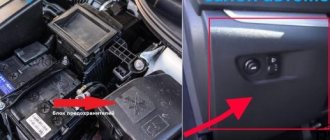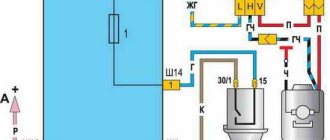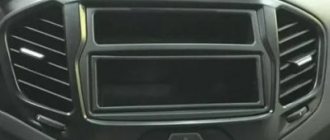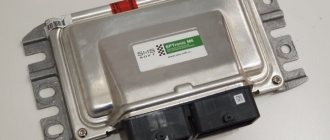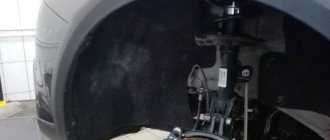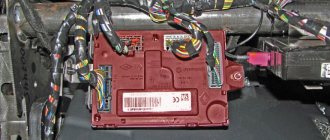In a Lada Vesta car, the stove heats the interior, but as it turns out, this is not its only function. They use it not only in winter, but also in summer. The territory of the Russian Federation is dominated by a temperate climate. In cold winter, the stove becomes an important function on a Lada Vesta car. This unit is necessary in the rain or cold, when you need to quickly remove fogging from the windows and warm up the few moving people in the cabin. In the advanced configuration of the Lada Vesta, the air conditioner can create a comfortable temperature in hot weather. The Lada Vesta stove does its job well. But like in any car, problems happen: the heater radiator leaks, the fan makes noise, or there is vibration. Replacing the stove is important on a Lada Vesta car not only in winter but also in summer. Read the article and you will be warm and comfortable in your car.
The radiator and stove assembly for Vesta look like this
How the stove works on Lada Vesta (process description)
- A small interior radiator is connected through pipes to the engine cooling system, it is from this that the heat comes, and the heater starts working from it;
- The heat received from the radiator is dispersed throughout the cabin by an electric fan, which forces air into the air duct nozzles;
- The resistor (RFV) sets the operating rate of the electric fan;
- The cabin air filter is installed at the outlet of the electric fan;
- A damper is installed in the air ducts, which controls the flow of air reaching passengers;
- The gearmotor moves the air flow distribution damper according to the task;
- And the tasks are distributed by the control unit for the heater (stove) and, if available, the air conditioner. Under the control of the SAUKU unit (heater and air conditioning control unit) there is a fan, gearbox, and various heater sensors.
The SAUKU block looks like this - a typical Vesta classic
Stove malfunctions
Lada Vesta is a warm car. The car should be warm and comfortable. If this is not the case, it means that one of the heater elements has broken down. What problems you may encounter:
- The temperature of the supplied air does not correspond to the declared one (the system does not have enough antifreeze, the radiator of the Lada Vesta stove is clogged, an air lock has formed in the pipes, etc.);
- Vibration of the stove or extraneous noise (most likely this is an electrically driven ventilation device);
- Weak or excessive air flow (dampers are not working properly);
- The heater does not work at all (there may be problems with the electronic control system, serious damage to the heater body, etc.).
Topic: Heater fan noise and vibration
Car: Lada Vesta
Lada Vesta with a stove
Lada Vesta with a stove
Well, Lada fans, did you think Vesta would save you from shame and you could drive with your head up? Catch...
One of the differences between the Vesta heater and other Lada cars
(for example, Grants or Priors) is that the cabin filter is installed after the fan. This design feature makes it easy for debris and dirt to get into the blades, which causes extraneous noise (whistle, howl, rustle) or vibration.
Over 10,000 km, dust accumulates on the fan blades; the thickness of this layer can be several millimeters. Also, pieces of debris (a twig, leaf, etc.) may get stuck between the blades.
All this causes imbalance during rotation.
Sometimes at speed 4 of the stove the vibration is so strong that it causes noise and is even transmitted to the steering wheel of the car. And the leaves in the impeller create an unbearable rustling and whistling sound.
Dirty heater fan impeller Lada Vesta
Dirty heater fan impeller Lada Vesta
An adequate owner will not make the music louder and ignore the problem, so I am writing about the solution.
The main task is to clean the heater fan from dust and dirt.
To check vibrations, you can connect a motor from a battery. If necessary, to reduce vibrations, we rearrange the balancing weights to other blades.
Is dirt getting on the ventilation system fan covered under warranty?
AvtoVAZ responds,
that when operating Lada Vesta vehicles under warranty, vibration may be felt by the consumer on the steering wheel and instrument panel.
“The reason for this is the operation of the interior heater fan at 2nd and higher speeds with dust/dirt and/or other foreign objects on the fan impeller. Dust accumulation occurs when the vehicle is used for a long time on polluted public roads, on dirt and field roads with the fan not working, which is a failure to follow the recommendations set out in the operating manual.”
How do you like it? You paid money for a car that they designed with a jamb, and the manufacturer tells you that it’s your own fault!
Avtotaz itself solves this problem as follows:
1. Place the car in the workplace, brake with the parking brake, open the hood, disconnect the earth wire terminal from the battery (spanner 10).
2. Remove the heater fan.
Heater fan from Valeo (costs a lot of money)
Heater fan from Valeo (costs a lot of money)
3. Blow out the heater fan impeller with compressed air to remove dust, dirt and foreign objects (compressed air blow gun).
4. Wash the heater fan impeller with a cleaning solution to remove any remaining dust and dirt, avoiding contact of the cleaning solution with the heater fan motor (technological container, brush, wiping cloth, cleaning solution - water, liquid soap).
5. Use a rag to wipe off the remaining cleaning solution from the heater fan impeller (wiping rag).
Heater fan from Valeo (costs a lot of money)
Heater fan from Valeo (costs a lot of money)
6. Install the heater fan on the car.
7. Connect the earth wire terminal to the battery (spanner 10).
8. Turn on the ignition, turn on the heater fan at 2nd and higher speeds, make sure that there is no increased vibration of the fan in all operating modes. Turn off the fan and ignition.
Subscribe to the channel, like, write comments, let's talk!
It will also be interesting to read about the Lada Granta, which has less than six months left on the assembly line, and the Lada Vesta with a mileage of 400 thousand km. and all the problems of the Lada variator.
Channel on Zen: https://zen.yandex.ru/smolavtodetal
Vkontakte group: https://vk.com/public169283288
Drive2 page: https://www.drive2.ru/o/SmolAvtoDetal#blog
#online auto parts store#spare parts for foreign cars#auto partssmolensk
Online store https://smolavtodetal.ru/
Working hours: Mon – Fri from 10:00 to 19:00
Sat – Sun from 10:00 to 16:00
Tel., mob. 8-905-696-65-75
Checking the stove fan
The Vesta cabin filter is located above the blades of the unit. The job of the filter element is to collect dust and debris coming from the street. It is possible that these particles may penetrate into the ventilation device. Leaves or pebbles begin to rotate inside the impeller - the fan makes noise.
- To clean it, you need to make access to it free;
- To do this, remove the glove compartment and take out the filter element;
- Now, on the right side of the furnace body we find the mechanism. We clamp the petal located at the top, turn the impeller counterclockwise, and remove the motor;
- We clean the engine with napkins and cotton swabs. One of the reasons for the slowly working mechanism is a dense layer of dust on the walls;
- We install the unit in place and assemble the interior plastic.
There are other typical unit malfunctions. To diagnose them, analyze the operation of the device at different speeds. If one of them does not work, check the wiring and the serviceability of the additional resistor (RFV).
If the Lada fan does not blow at all, the cause may be a blown fuse. Then you don’t need to disassemble anything, just replace the circuit element in the fuse control unit.
Disassembly - cleaning the fan
As I already wrote above, in each car the removal of this device is done differently, but the essence always remains the same, we either have the fan completely removed or there is direct access to it so that the elements can be lubricated.
I WOULD LIKE TO CAUTION - before you remove the electric motor, disconnect the terminals from the car battery to avoid unnecessary unnecessary short circuits.
The fan is almost always designed the same way - it is an electric motor and at the top there is a cylindrical comb (blades) that pumps air. Here's a small example.
Checking the stove dampers
As you already know, air is pumped into the interior of the Lada Vesta by an electric fan through air ducts. It would be possible to drive air directly without using air pipes. However, then it would be impossible to regulate the speed and direction of air flows. For the orderly movement of air masses, an air flow distribution damper is used, which is located between the fan and the outlet from the air duct. There are several of the latter on the dashboard, and accordingly there are the same number of dampers.
Like any mechanism, the dampers that distribute air fail. To detect it, we will check the maximum power of the Lada heating device. This is exactly how the malfunction makes itself felt most easily.
If the volume of incoming gas does not change when moving the mode control lever. This means that the motion limiter does not operate. Most likely, the signal is lost along the way (electric drive). If you hear a creaking or noise when switching the heating mode. Lubricate the dampers with a lubricant containing silicone. Why do windows fog up?
When there is a large difference in temperature or humidity inside the cabin, a coating of water droplets forms on the glass. This is a very dangerous condition - the driver cannot see the road. One of the main functions of the stove is to quickly remove fogging. To do this, several air duct nozzles are directed at the windshield, as well as the side windows of the Lada Vesta. The luxury version also uses heated mirrors.
A working device quickly restores the windows to their normal state. This is achieved by supplying hot air to the surface. Therefore, if Vesta’s windows do not fog up, the reason for this is a faulty radiator.
Problems
Stove motor During operation, the device may become unusable or reduce its efficiency.
We check the fan at all four speeds:
- if the fan stops rotating, look at the safety element in the control unit;
- if one of the speeds does not work, the reason is a breakdown of the additional resistor or car wiring.
- When the fan operates at low intensity, you need to clean the air intake grille or filter.
We check the dampers - at maximum speed, use the keys to change the distribution modes:
- if they do not move, the problem is in their electric drive;
- If the Lada Vesta heater dampers squeak, you should lubricate them with silicone grease.
We warm up the engine to operating temperature, then watch how the pipes are heated. The problem lies in the different temperatures of these elements:
- minimum antifreeze level is likely;
- you need to force out the air plug through a specialized valve;
- If the radiator is clogged, replacement is necessary.
Checking heating efficiency
The heater should be checked before the start of the winter season, and also several times in winter. Then troubles will not take you by surprise. To do this, you need to check the operation in all modes and evaluate:
- Does the air heat up and how quickly?
- Does the flow of air masses change with a change in command;
- Are there any extraneous noises?
- In general, are you satisfied with the operation of the heater?
Particular attention should be paid to the same temperature of the pipes. If the difference in the heating of rubber pipelines is significant, this means a serious problem. It's worth finding. In the worst case, this means replacing the Vesta radiator; in the best case, airing or a low level of antifreeze.
Standard heater radiator
The heater radiator is the same in design as the radiator of the Lada cooling system, only smaller. They have a common antifreeze range. Dirt from the expansion tank may also end up in the small interior assembly. Unfortunately, the radiator cannot be repaired. Need a replacement. When we come closer to the question, it turns out that the standard unit does not have a serial number. There is only a code - UT-00006936, according to which they can sell you another spare part. Therefore, before purchasing, check with the seller for information.
Replacing the radiator of the VAZ 21129 Lada Vesta stove
To replace a stove radiator with your own hands:
- It is necessary to turn off the power to the car, free the cooling system from antifreeze;
- Remove the plastic trim of the instrument panel;
- Remove the top panel in the glove compartment, remove the glove compartment;
- The unit is located in the heater block on the driver's side, you need to free access to it - remove the metal pillar of the dashboard frame, remove the air pipe for heating the driver's feet;
- Disconnect the pipes (be prepared for antifreeze leaks);
- Open the cover of the stove device with a Torx screwdriver;
- Remove the heater/cooler from the heater housing;
- Install a new spare part;
- Reassemble the structure in reverse order.
Lada Vesta drives on Russian roads. Passengers should be warm and comfortable. The new AvtoVAZ stove (with a cooling glove compartment for drinks, heating the driver’s feet) copes with its job “excellently”. But any device fails sooner or later. If faults are diagnosed and corrected in time, the device will warm your feet and soul for a long time.
Lada X Ray
You can independently eliminate the noise of the Lada X-Ray heater fan using one of 2 options:
- Through the top panel in the glove box;
- Through the cabin filter.
First way
Compared to Vesta, it is noticeably simpler due to the fact that you do not have to dismantle several components at once, although it is not as convenient to work with.
First you need to remove the top panel in the glove box on which the lamp is located.
The motor itself is on the left. To remove the impeller, you need to lightly press the top plastic lock and carefully turn the fan counterclockwise.
It is worth noting that it will not be possible to completely remove the motor, since this will require disassembling part of the dashboard. However, even the indicated hole is enough to clean the blades with a thin screwdriver wrapped in cloth.
Second way
To implement this option for eliminating heater fan noise in the Lada X-Ray, you will first need to remove the cabin filter and frill on the passenger side.
To get to the cabin filter, you need to remove the plastic lining of the transmission tunnel on the front passenger side (fastened with screws), and then, according to the above algorithm, remove the glove box lid (if necessary).
Next, you need to squeeze the latches and remove the filter cover.
To remove the filter itself from the housing, you need to grab its lower edge and then pull. After removal, it is recommended to clean the seat from debris (leaves, dust, etc.).

